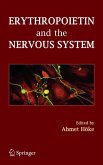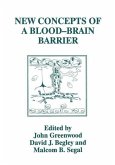Implications of the Blood-Brain Barrier and Its Manipulation (eBook, PDF)
Volume 1 Basic Science Aspects
Redaktion: Neuwelt, E. A.


Alle Infos zum eBook verschenken

Implications of the Blood-Brain Barrier and Its Manipulation (eBook, PDF)
Volume 1 Basic Science Aspects
Redaktion: Neuwelt, E. A.
- Format: PDF
- Merkliste
- Auf die Merkliste
- Bewerten Bewerten
- Teilen
- Produkt teilen
- Produkterinnerung
- Produkterinnerung

Hier können Sie sich einloggen

Bitte loggen Sie sich zunächst in Ihr Kundenkonto ein oder registrieren Sie sich bei bücher.de, um das eBook-Abo tolino select nutzen zu können.
Understanding the structure and function of the blood-brain barrier (BBB) and recogniz ing its clinical relevance require a concert of scientific disciplines applied from a view point of integrative physiology rather than from only molecular or analytical approaches. It is this broad scope that is emphasized in this book. In my opinion, four original contributions define the field as it exists today. The first, a monograph by Broman,1 entitled The Permeability of the Cerebrospinal Vessels in Normal and Pathological Conditions, was the model for many subsequent clinical and 3 experimental…mehr
- Geräte: PC
- ohne Kopierschutz
- eBook Hilfe
- Größe: 53.05MB
![Tumors of the Brain and Spine (eBook, PDF) Tumors of the Brain and Spine (eBook, PDF)]() Tumors of the Brain and Spine (eBook, PDF)106,99 €
Tumors of the Brain and Spine (eBook, PDF)106,99 €![Erythropoietin and the Nervous System (eBook, PDF) Erythropoietin and the Nervous System (eBook, PDF)]() Erythropoietin and the Nervous System (eBook, PDF)113,95 €
Erythropoietin and the Nervous System (eBook, PDF)113,95 €![Otfrid Foerster · Physician and Naturalist (eBook, PDF) Otfrid Foerster · Physician and Naturalist (eBook, PDF)]() Klaus Joachim ZülchOtfrid Foerster · Physician and Naturalist (eBook, PDF)40,95 €
Klaus Joachim ZülchOtfrid Foerster · Physician and Naturalist (eBook, PDF)40,95 €![New Concepts of a Blood-Brain Barrier (eBook, PDF) New Concepts of a Blood-Brain Barrier (eBook, PDF)]() New Concepts of a Blood-Brain Barrier (eBook, PDF)113,95 €
New Concepts of a Blood-Brain Barrier (eBook, PDF)113,95 €![Neurology Study Guide (eBook, PDF) Neurology Study Guide (eBook, PDF)]() Teresella GondoloNeurology Study Guide (eBook, PDF)40,95 €
Teresella GondoloNeurology Study Guide (eBook, PDF)40,95 €![Blood-Brain Barrier Permeability Changes after Subarachnoid Haemorrhage: An Update (eBook, PDF) Blood-Brain Barrier Permeability Changes after Subarachnoid Haemorrhage: An Update (eBook, PDF)]() Antonio F. GermanoBlood-Brain Barrier Permeability Changes after Subarachnoid Haemorrhage: An Update (eBook, PDF)40,95 €
Antonio F. GermanoBlood-Brain Barrier Permeability Changes after Subarachnoid Haemorrhage: An Update (eBook, PDF)40,95 €![Biology and Physiology of the Blood-Brain Barrier (eBook, PDF) Biology and Physiology of the Blood-Brain Barrier (eBook, PDF)]() Biology and Physiology of the Blood-Brain Barrier (eBook, PDF)161,95 €
Biology and Physiology of the Blood-Brain Barrier (eBook, PDF)161,95 €-
-
-
Dieser Download kann aus rechtlichen Gründen nur mit Rechnungsadresse in A, B, BG, CY, CZ, D, DK, EW, E, FIN, F, GR, HR, H, IRL, I, LT, L, LR, M, NL, PL, P, R, S, SLO, SK ausgeliefert werden.
- Produktdetails
- Verlag: Springer US
- Seitenzahl: 434
- Erscheinungstermin: 11. November 2013
- Englisch
- ISBN-13: 9781461307013
- Artikelnr.: 44177205
- Verlag: Springer US
- Seitenzahl: 434
- Erscheinungstermin: 11. November 2013
- Englisch
- ISBN-13: 9781461307013
- Artikelnr.: 44177205







